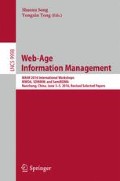Abstract
With an increasing number of short text emerging, sparse text classification is becoming crucial in data mining and information retrieval area. Many efforts have been devoted to improve the efficiency of normal text classification. However, it is still immature in terms of high-dimension and sparse data processing. In this paper, we present a new method which fancifully utilizes Biterm Topic Model (BTM) and Support Vector Machine (SVM). By using BTM, though the dimensionality of training data is reduced significantly, it is still able to keep rich semantic information for the sparse data. We then employ SVM on the generated topics or features. Experiments on 20 Newsgroups and Tencent microblog dataset demonstrate that our approach can achieve excellent classifier performance in terms of precision, recall and F1 measure. Furthermore, it is proved that the proposed method has high efficiency compared with the combination of Latent Dirichlet Allocation (LDA) and SVM. Our method enhances the previous work in this field and establishes the foundation for further studies.
Access this chapter
Tax calculation will be finalised at checkout
Purchases are for personal use only
References
Altınel, B., Ganiz, M.C., Diri, B.: A corpus-based semantic kernel for text classification by using meaning values of terms. Eng. Appl. Artif. Intell. 43, 54–66 (2015)
Cataldi, M., Di Caro, L., Schifanella, C.: Emerging topic detection on twitter based on temporal and social terms evaluation. In: Proceedings of the Tenth International Workshop on Multimedia Data Mining, p. 4. ACM (2010)
Chang, C.-C., Lin, C.-J.: Libsvm: a library for support vector machines. ACM Trans. Intell. Syst. Technol. (TIST) 2(3), 27 (2011)
Cheng, X., Yan, X., Lan, Y., Guo, J.: BTM: topic modeling over short texts. IEEE Trans. Knowl. Data Eng. 26(12), 2928–2941 (2014)
Dhillon, I.S., Modha, D.S.: Concept decompositions for large sparse text data using clustering. Mach. Learn. 42(1–2), 143–175 (2001)
Fan, R.-E., Chang, K.-W., Hsieh, C.-J., Wang, X.-R., Lin, C.-J.: Liblinear: a library for large linear classification. J. Mach. Learn. Res. 9, 1871–1874 (2008)
Lai, S., Xu, L., Liu, K., Zhao, J.: Recurrent convolutional neural networks for text classification. In: AAAI, pp. 2267–2273 (2015)
Landeiro, V., Culotta, A.: Robust text classification in the presence of confounding bias (2016)
Liu, C.-L., Hsaio, W.-H., Lee, C.-H., Chang, T.-H., Kuo, T.-H.: Semi-supervised text classification with universum learning. IEEE Trans. Cybern. 46(2), 462–473 (2015)
Luo, L., Li, L.: Defining and evaluating classification algorithm for high-dimensional data based on latent topics. PloS one 9(1), e82119 (2014)
Luss, R., d’Aspremont, A.: Predicting abnormal returns from news using text classification. Quant. Financ. 15(6), 999–1012 (2015)
Minh, H.Q., Niyogi, P., Yao, Y.: Mercer’s theorem, feature maps, and smoothing. In: Lugosi, G., Simon, H.U. (eds.) COLT 2006. LNCS (LNAI), vol. 4005, pp. 154–168. Springer, Heidelberg (2006). doi:10.1007/11776420_14
Moura, S., Partalas, I., Amini, M.-R.: Sparsification of linear models for large-scale text classification. In: Conférence sur l’APprentissage automatique (CAp 2015) (2015)
Nguyen, V.T., Huy, H.N.K., Tai, P.T., Hung, H.A.: Improving multi-class text classification method combined the svm classifier with oao and ddag strategies. J. Convergence Inf. Technol. 10(2), 62–70 (2015)
Phan, X.-H., Nguyen, L.-M., Horiguchi, S.: Learning to classify short and sparse text & web with hidden topics from large-scale data collections. In: Proceedings of the 17th International Conference on World Wide Web, pp. 91–100. ACM (2008)
Seetha, H., Murty, M.N., Saravanan, R.: Effective feature selection technique for text classification. Int. J. Data Min. Model. Manag. 7(3), 165–184 (2015)
Shalev-Shwartz, S., Singer, Y., Srebro, N., Cotter, A.: Pegasos: primal estimated sub-gradient solver for svm. Math. Program. 127(1), 3–30 (2011)
Song J., Zhang P., Qin S., Gong, J.: A method of the feature selection in hierarchical text classification based on the category discrimination and position information. In: 2015 International Conference on Industrial Informatics-Computing Technology, Intelligent Technology, Industrial Information Integration (ICIICII), pp. 132–135. IEEE (2015)
Wang, J., Li, L., Tan, F., Zhu, Y., Feng, W.: Detecting hotspot information using multi-attribute based topic model. PloS one 10(10), e0140539 (2015)
Xia, C.-Y., Wang, Z., Sanz, J., Meloni, S., Moreno, Y.: Effects of delayed recovery and nonuniform transmission on the spreading of diseases in complex networks. Phys. A: Stat. Mech. Appl. 392(7), 1577–1585 (2013)
Yan, X., Guo, J., Lan, Y., Cheng, X.: A biterm topic model for short texts. In: Proceedings of the 22nd International Conference on World Wide Web, pp. 1445–1456. International World Wide Web Conferences Steering Committee (2013)
Yin, C., Xiang, J., Zhang, H., Wang, J., Yin, Z., Kim, J.-U.: A new svm method for short text classification based on semi-supervised learning. In: 2015 4th International Conference on Advanced Information Technology and Sensor Application (AITS), pp. 100–103. IEEE (2015)
Zhang, H., Zhong, G.: Improving short text classification by learning vector representations of both words and hidden topics. Knowl.-Based Syst. 102, 76–86 (2016)
Acknowledgments
This work is supported by Natural Science Foundations of China (No. 61170192), National High-tech R&D Program of China (No. 2013AA013801), Fundamental Research Funds for the Central Universities (No. XDJK2016E064).
Author information
Authors and Affiliations
Corresponding author
Editor information
Editors and Affiliations
Rights and permissions
Copyright information
© 2016 Springer International Publishing AG
About this paper
Cite this paper
Wang, G., Zhang, J., Yang, X., Li, L. (2016). A Hybrid Approach for Sparse Data Classification Based on Topic Model. In: Song, S., Tong, Y. (eds) Web-Age Information Management. WAIM 2016. Lecture Notes in Computer Science(), vol 9998. Springer, Cham. https://doi.org/10.1007/978-3-319-47121-1_2
Download citation
DOI: https://doi.org/10.1007/978-3-319-47121-1_2
Published:
Publisher Name: Springer, Cham
Print ISBN: 978-3-319-47120-4
Online ISBN: 978-3-319-47121-1
eBook Packages: Computer ScienceComputer Science (R0)

